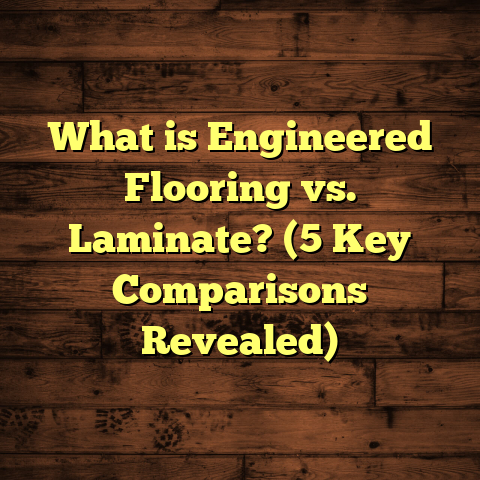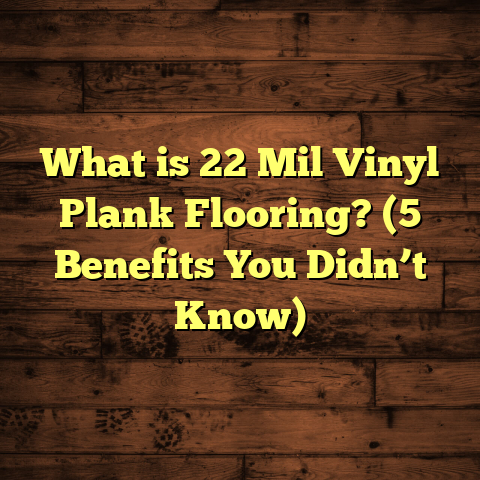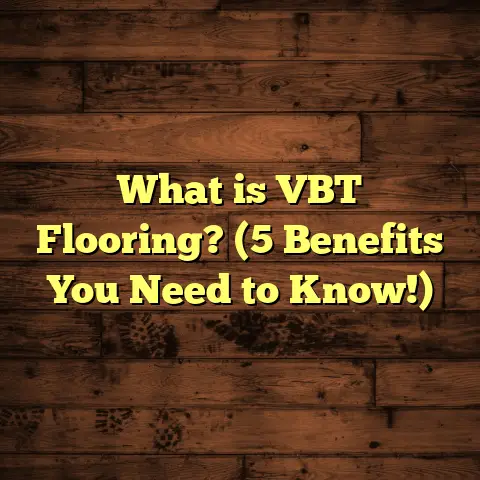What is Modular Flooring? (5 Advantages for Modern Spaces)
Ease of care is often the first thing I think about when choosing flooring. I’m not alone here—whether it’s in my own home or working with clients, no one wants to wrestle with floors that demand endless scrubbing or special cleaners. Modular flooring caught my attention because it offers a practical solution to this common hassle. Over the years, after experimenting with various types and installations, I’ve gathered a lot of insights about what makes modular flooring a smart choice for modern spaces.
I want to share everything I’ve learned—from how modular flooring works to the real-world advantages it offers. Plus, I’ll include examples from my projects, some data, and tips on managing costs effectively using tools like FloorTally. Let’s get into it.
What is Modular Flooring?
Modular flooring refers to floor coverings made up of individual pieces or units, like tiles or planks, designed to fit together and cover a surface. Unlike traditional flooring materials that come in continuous sheets or large boards, modular flooring is all about assembling smaller, interchangeable components.
You can think of these modules as building blocks for your floor. They come in different shapes—square carpet tiles, rectangular vinyl planks, even hexagonal rubber tiles—and materials—vinyl, carpet, rubber, laminate, engineered wood. The defining feature is their modularity: each piece can be installed, removed, or replaced independently.
When I first started using modular flooring in my projects, I was surprised by how many material types offer modular products now. For example:
- Vinyl plank flooring: These are rigid or flexible planks that click together and mimic wood, stone, or other natural textures.
- Carpet tiles: Small square pieces of carpet that you lay down like puzzle pieces.
- Rubber tiles: Popular in gyms and play areas because of their comfort and durability.
- Laminate planks: Some brands offer click-lock laminate planks designed for modular installation.
- Engineered wood planks: Modular versions are available that click together for easier installation than traditional hardwood.
What’s cool is how modular flooring turns floor installation into a more flexible and approachable process. You don’t need specialized tools or adhesives in many cases; often it’s just clicking pieces together or peeling and sticking.
My First Experience with Modular Flooring
I remember one of my early projects: installing modular vinyl plank flooring in a client’s kitchen. The client wanted something durable but stylish and easy to maintain since the kitchen sees a lot of foot traffic and spills.
The vinyl planks locked together quickly without glue or nails. Installation took me half the time it would have taken for a glue-down sheet vinyl job. And when one plank got scratched during moving heavy furniture in later months, the client could replace just that plank rather than rip up the whole floor.
That experience was an eye-opener. It made me realize modular flooring wasn’t just a “nice to have” but could save time, money, and headaches long-term.
How Modular Flooring Compares to Other Flooring Options
Over the years, I’ve worked with all sorts of flooring materials. Each type comes with its own set of benefits and challenges. Here’s how modular flooring stacks up against some common options I’ve used:
Solid Hardwood
Solid hardwood has been a classic choice for centuries—rich, warm, and authentic. But it’s also expensive and requires careful maintenance. It’s prone to scratches and water damage, so not ideal for high-moisture areas like kitchens or basements.
Installing solid hardwood typically involves nailing down planks or glueing engineered layers—both labor-intensive processes that usually require professionals.
In contrast, modular hardwood-style planks are often engineered wood with click systems that make installation simpler and faster. However, they might not last as long as solid hardwood but offer better moisture resistance.
Engineered Wood
Engineered wood combines layers of wood veneer with plywood bases for improved stability. It gives you the look of hardwood with better resistance to environmental changes.
Installation is easier than solid wood but still isn’t as user-friendly as modular click-lock systems on vinyl or laminate.
Modular engineered wood can be a good middle ground if you want real wood aesthetics with easier installation.
Laminate Flooring
Laminate mimics wood or stone by layering photographic images under tough melamine resin. It’s affordable and scratch resistant but can feel less natural underfoot.
Many laminate products come as modular planks with click-lock design. I’ve installed plenty of these myself—they’re great for budget-conscious clients who want easy DIY solutions.
However, laminate doesn’t handle moisture well and can swell when wet—something to keep in mind.
Vinyl Sheet Flooring
Vinyl sheet comes in large rolls that are glued down. It’s waterproof, affordable, and comes in lots of patterns.
The downside is installation can be messy due to adhesives, and repairs are difficult—if one section gets damaged you may have to replace a large area.
Modular vinyl plank flooring solves this problem by breaking the floor into replaceable pieces.
Carpet Rolls
Carpet rolls create soft surfaces but stain easily and require professional stretching during installation.
Carpet tiles offer an alternative—modular squares you can replace individually if stained or worn out. Plus they allow mixing colors and patterns for creative effects.
The 5 Advantages of Modular Flooring for Modern Spaces
Let me break down five reasons why I often recommend modular flooring based on what I’ve seen firsthand.
1. Easy Installation & Maintenance
This one’s huge for me. I’m not always working on massive projects with big budgets where time isn’t a factor. Many times clients want quick turnarounds or even DIY solutions.
Modular flooring often uses click-lock systems or peel-and-stick backs that anyone with basic tools can handle.
Take carpet tiles: I installed these myself once in a home office. It took me just a weekend to complete over an existing floor. No glue mess or drying time needed.
When it comes to maintenance, think about how modular flooring makes repairs simple too. Got a coffee spill that ruined one carpet tile? Pull it up and swap in a new one without ripping out the entire carpet.
For vinyl planks or laminate tiles, replacing damaged pieces saves time and money compared to redoing whole rooms—a major plus for busy households or commercial spaces where downtime is costly.
2. Design Flexibility & Customization
Modular flooring lets you get creative in ways traditional flooring can’t easily match.
Ever wanted to mix colors or patterns without complicated cutting and waste? With modular tiles or planks you can lay down checkerboard carpets or alternate vinyl plank tones without stress.
A client once asked me to design a custom pattern for her boutique store floor using geometric shapes made from different colors of carpet tiles. Using modular flooring made this possible at a reasonable price point and with minimal material waste.
The ability to create unique looks boosts property value too—buyers appreciate floors that add personality without sacrificing practicality.
3. Durability vs Cost Balance
I love data-backed decisions, so here are some insights from my experience and market research:
| Flooring Type | Lifespan (years) | Cost per Sq Ft (USD) | Repair Difficulty (1-hardest to 5-easiest) |
|---|---|---|---|
| Solid Hardwood | 30+ | $8 – $12 | 2 |
| Engineered Wood | 20 | $6 – $10 | 3 |
| Laminate | 15 | $2 – $5 | 3 |
| Vinyl Sheet | 10 | $1.50 – $4 | 2 |
| Carpet Roll | 8 – 10 | $2 – $6 | 1 |
| Modular Vinyl Plank | 15 – 20 | $3 – $7 | 5 |
| Carpet Tiles | 10 – 15 | $3 – $8 | 5 |
Modular options tend to hit a sweet spot between durability and cost-effectiveness. Vinyl plank floors resist scratches better than laminate at similar price points while allowing easy repairs.
This balance makes modular floors ideal for families with kids or pets who want durable surfaces without breaking the bank.
4. Environmentally Responsible Choices
Sustainability is more than a buzzword—it’s become a buying factor for many clients I work with.
Modular flooring often incorporates recycled content or recyclable materials:
- Vinyl plank manufacturers increasingly use recycled PVC.
- Carpet tile producers use recyclable backing materials.
- Bamboo engineered planks provide fast-growing renewable wood options.
- Rubber tiles often come from recycled tires.
Sales data shows eco-friendly flooring sales have jumped over 25% annually recently as consumers look for green alternatives.
If reducing environmental impact matters to you (as it does to me), modular flooring offers options that align with those values while staying practical.
5. Versatility Across Different Room Types
I’ve installed modular flooring in all sorts of spaces—residential kitchens, home offices, gyms, retail shops—and each setting benefited differently:
- Kitchens & Bathrooms: Waterproof vinyl planks resist spills better than hardwood.
- Basements: Modular tile systems deal better with moisture fluctuations.
- Commercial Gyms: Rubber tiles absorb impact and are easy to replace after wear.
- Offices: Carpet tiles reduce noise and allow quick maintenance.
- Rental Units: Tenants can swap out damaged sections without landlord expense.
The flexibility makes modular flooring perfect for spaces that change often or have uneven layouts where traditional flooring installation is tricky.
Personal Stories & Case Studies from My Projects
One memorable project was a co-working space where we used modular carpet tiles throughout multiple rooms totaling over 5,000 square feet. The client wanted noise reduction but also easy maintenance since lots of people would be coming through daily.
Using carpet tiles saved significant installation time—about 30% faster than broadloom carpet—and when the client discovered a coffee stain on one tile after opening day, replacing it was painless.
Another example was a gym renovation where we switched from old rubber mats to new interlocking rubber tiles. The client appreciated how we didn’t have to shut down the entire gym—the modular system allowed phased installation during off-hours. Plus replacing worn tiles later was much cheaper than redoing the whole floor.
For my own home office makeover, I chose peel-and-stick vinyl planks because I wanted a DIY project that looked professional but didn’t require special tools or contractors. It took two afternoons over a weekend and transformed the room into a comfortable workspace without breaking my budget.
How I Use FloorTally for Accurate Cost Estimates
Estimating costs accurately is tricky—especially when dealing with mixed materials or custom patterns common in modular flooring projects.
That’s where FloorTally comes in handy for me. It lets me:
- Enter exact quantities based on room dimensions
- Select materials from local suppliers with up-to-date pricing
- Include labor costs based on location
- Add waste factors (usually around 5-7% for modular pieces)
- Adjust for design complexity like patterns or mixed materials
By consolidating all these variables into one estimate, FloorTally saves time and cuts out guesswork. It’s especially useful when presenting budgets to clients who want clear cost breakdowns upfront.
For example, during a recent mixed-use office remodel combining carpet tiles and vinyl planks totaling about 2,000 sq ft, FloorTally generated detailed cost reports including labor and material subtotals within minutes—much faster than manually calculating each line item.
Additional Tips & Tricks I’ve Learned Working with Modular Flooring
Since working extensively with modular floors, here are some practical tips I often share:
- Always order extra material: A waste factor of about 5-7% accounts for cutting errors and future repairs.
- Use layout software: Visualizing patterns digitally before installation helps avoid surprises.
- Prepare subfloor properly: Smooth, clean surfaces ensure modules fit tightly without gaps.
- Consider room function: Choose materials based on traffic level and moisture exposure.
- Plan transitions in advance: Modular floors work well with metal or rubber transition strips for adjoining floor types.
- Test small samples first: Get familiar with locking mechanisms before tackling large areas.
These little insights save headaches later on!
Addressing Common Questions About Modular Flooring
Q: Can modular flooring be installed over existing floors?
Yes! Most modular floors can go over concrete slabs, plywood subfloors, or even some existing hard floors if flat and clean.
Q: How do I clean modular floors?
Maintenance depends on material but generally involves vacuuming/dry mopping regularly plus spot cleaning spills immediately using manufacturer recommendations.
Q: Are modular floors noisy?
Carpet tiles reduce noise well; vinyl planks can be noisier but soundproof underlayment helps minimize footfall noise.
Q: Can I install modular flooring myself?
Absolutely! Many products come designed for DIY installation; just follow instructions carefully and take your time laying pieces evenly.
Why Modular Flooring Makes Sense Now More Than Ever
We live in times where flexibility matters—in how we live, work, and design our spaces. Modular flooring fits this mindset perfectly:
- It adapts easily if your needs change.
- It saves money by allowing selective repairs.
- It supports sustainability goals through recyclable materials.
- It offers stylish customization without huge costs.
- It reduces downtime in commercial settings thanks to fast installation and repair options.
For people like me who juggle multiple projects or prefer practical solutions at home without sacrificing style, modular flooring hits the mark well.
If you’re thinking about upgrading your floors soon—or just curious about options—modular flooring deserves serious thought. Feel free to ask me any questions! Whether you want help picking materials or advice on installation techniques, I’m happy to share what I’ve learned over years on the job.
Have you ever tried modular floors? What’s your experience been like?





